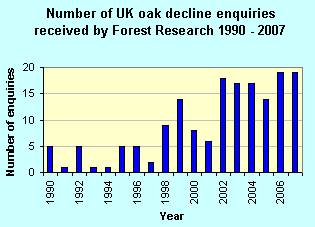Current forms of oak decline
We currently recognise two forms of oak decline:
- Chronic oak decline or dieback which has been recognised for almost 100 years.
- Acute oak decline which is a fast moving disorder that has become apparent in the last few years.
New concerns about oak decline
Over the past five years, there have been a number of reports sent into the Forest Research Tree Health Diagnostic and Advisory Service about a resurgence in oak decline with trees showing symptoms of dieback.
The reported cases are widely distributed and particularly since 2002 there has been a significant increase in reported sites with severe oak decline as shown by the graph.

Just as in the early 1990s, several reports comment on the acute nature of the dieback and decline. In some, very high proportions of trees are affected on individual sites and many trees have died or had to be removed within just a few years of the first foliar symptoms becoming apparent.
The exact reasons for the current episode of oak decline are being elucidated, but a new causal agent may be involved. Due to the rapid onset of decline and high level of mortality on some sites, this particular form of decline is known as acute oak decline.
